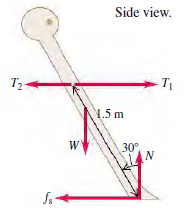His body is again leaning back at 30.0 o to the vertical, but now the height at
Question:
(a) The moment arm of the rope about his feet decreases due to the angle that his body makes with the vertical;
(b) The moment arm of the weight about his feet decreases due to the angle that his body makes with the vertical;
(c) A smaller tension in the rope is needed to produce a torque sufficient to balance the torque of the weight about his feet;
(d) His center of mass moves down to compensate, so less tension in the rope is required to maintain equilibrium.
In a study of the biomechanics of the tug-of-war, a 2.0-m-tall, 80.0-kg competitor in the middle of the line is considered to be a rigid body leaning back at an angle of 30.0o to the vertical. The competitor is pulling on a rope that is held horizontal a distance of 1.5 m from his feet (as measured along the line of the body). At the moment shown in the figure, the man is stationary and the tension in the rope in front of him is T1 = 1160 N. Since there is friction between the rope and his hands, the tension in the rope behind him, T2, is not equal to T1. His center of mass is halfway between his feet and the top of his head. The coefficient of static friction between his feet and the ground is 0.65.

Step by Step Answer:

University Physics with Modern Physics
ISBN: 978-0133977981
14th edition
Authors: Hugh D. Young, Roger A. Freedman





